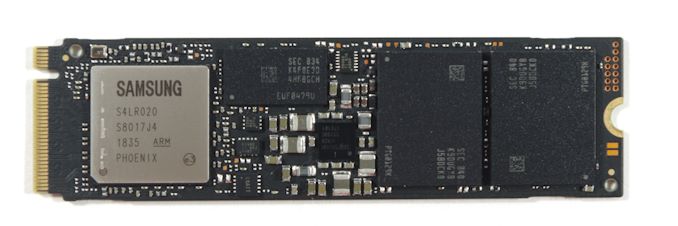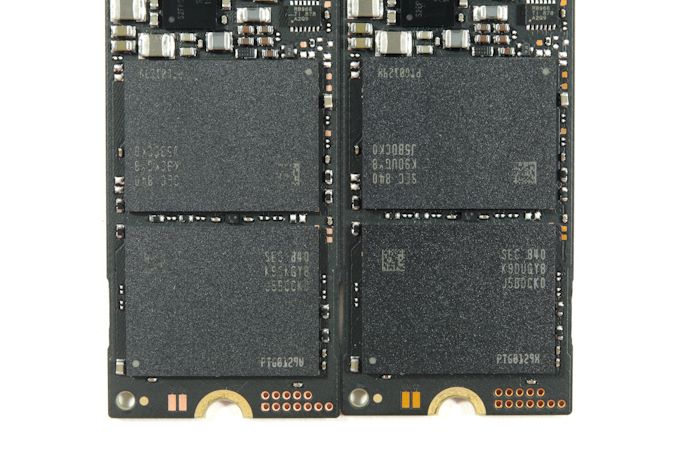The Samsung 970 EVO Plus (250GB, 1TB) NVMe SSD Review: 92-Layer 3D NAND
by Billy Tallis on January 22, 2019 10:00 AM ESTConclusion
The only technical change the Samsung 970 EVO Plus brings relative to last year's original 970 EVO is an upgrade from 64-layer 3D NAND to 92-layer 3D NAND. Fortunately, this change brings quite a few positive effects for end-users.
Samsung isn't the first to ship 9x-layer 3D NAND but they are the first to make it readily accessible to consumers in retail SSDs. This is Samsung's fifth generation 3D NAND and they have continued to improve not just the density and cost per GB, but also performance and power consumption. Those latter effects are more immediate, since the 970 EVO Plus is launching at similar prices to the 970 EVO it replaces. We do expect the 970 EVO Plus to continue the downward price trend that made 2018 such a great year for SSD buyers, but in the meantime the performance and power improvements are more interesting.
The 970 EVO Plus uses the same controller as the last generation of products, but it doesn't seem to get in the way of taking advantage of the new NAND's capabilities. With the 970 EVO Plus, Samsung retakes or strengthens their lead in some of our most challenging benchmarks. This is most noticeable in the tests that fill up the drive's SLC write cache, because the 970 EVO Plus has the best post-cache write speed we've measured from a TLC drive. This higher post-cache write speed is especially important given that Samsung's SLC caches are somewhat conservatively sized, at least in comparison to drives like the ADATA SX8200 that allow their SLC caches to grow to use almost the entire drive's array of flash memory.
The contrast between the SX8200's maximum size SLC cache strategy and the more reserved 970 EVO Plus cache sizes tends to allow the ADATA drive to perform better in ideal conditions, but hurts performance severely when the cache runs out. For the smallest drives in the 240GB–250GB range, ADATA's approach is probably a bit too aggressive because 240GB drives are fairly easy to fill up these days. A somewhat less aggressive SLC cache more like Samsung's mitigates the worst-case performance for the models that are most likely to actually hit that worst-case scenario in the real world.
Since the 970 EVO Plus does not introduce a new SSD controller, it still reflects Samsung's prioritization of performance over power efficiency. Western Digital and Toshiba have been demonstrating repeatedly that NVMe drives don't have to be power-hungry to hit the highest levels of performance, and Samsung is definitely lagging here in the overall picture. The 970 EVO Plus does score some efficiency wins, but only where it builds on the original 970 EVO's greatest strengths. For notebook use, the WD Black SN750's occasionally lower performance is absolutely worth the huge power savings.
| 240-280GB | 480-512GB | 960GB-1TB | 2TB | |
| Samsung 970 EVO Plus (MSRP) | $89.99 (36¢/GB) | $129.99 (26¢/GB) |
$249.99 (25¢/GB) |
|
| Samsung 970 EVO | $85.00 (34¢/GB) | $129.99 (26¢/GB) | $247.99 (25¢/GB) | $499.99 (25¢/GB) |
| Samsung 970 PRO | $167.99 (33¢/GB) | $399.99 (39¢/GB) | ||
| Western Digital WD Black SN750 (MSRP) | $79.99 (32¢/GB) | $129.99 (26¢/GB) | $249.99 (25¢/GB) | $499.99 (25¢/GB) |
| Western Digital WD Black (2018) | $84.99 (34¢/GB) | $119.98 (24¢/GB) | $234.99 (23¢/GB) | |
| ADATA XPG SX8200 Pro | $74.99 (29¢/GB) | $114.95 (22¢/GB) | $199.95 (20¢/GB) | |
| HP EX920 | $57.99 (23¢/GB) | $89.99 (18¢/GB) | $174.99 (17¢/GB) | |
| HP EX950 | $119.99 (23¢/GB) | $229.99 (22¢/GB) | $399.99 (20¢/GB) | |
| Mushkin Pilot | $59.99 (24¢/GB) | $99.99 (20¢/GB) | $189.99 (19¢/GB) | $399.99 (20¢/GB) |
| MyDigitalSSD BPX Pro | $54.99 (23¢/GB) | $99.99 (21¢/GB) | $189.99 (20¢/GB) | $519.99 (27¢/GB) |
| Corsair Force MP510 | $74.99 (31¢/GB) | $113.99 (24¢/GB) | $266.05 (28¢/GB) | $475.99 (25¢/GB) |
With Samsung launching the 970 EVO Plus at the same prices as the 970 EVO, they're taking one of the fastest TLC drives and making it a slightly better deal.
There aren't a lot of options for stepping up in performance from the 970 EVO Plus. The 970 PRO hasn't been updated to 96L NAND and has limited capacity options, and the Intel Optane SSD 900P is even more expensive. Both drives suffer from difficulty providing any tangible benefit over fast TLC drives for lighter workloads, and on heavier workloads the PCIe 3.0 x4 bottleneck becomes an issue. They also don't consistently beat the top TLC drives on synthetic benchmarks. Given what today's best TLC drives can do, MLC NAND and 3D XPoint memory both need to be regarded as niche options that cannot automatically be assumed to offer better real-world performance.
For most purposes, the 970 EVO Plus can now be regarded as Samsung's flagship consumer SSD, and it deserves that title. Its primary competition comes from NVMe drives that are much cheaper but offer similar real-world performance with lower worst-case synthetic benchmark performance.












35 Comments
View All Comments
ikjadoon - Tuesday, January 22, 2019 - link
Ah, wait. The 970 PRO isn't actually on Bench. I don't think it's been reviewed, right?Kvaern1 - Tuesday, January 22, 2019 - link
Completely not exciting. Don't care about a slight speed increase which no consumer is going to notice in the their daily use anyway. All that matters in the consumer NAND space at this point is bringing prices down, which is very unlikely to happen in a business with no real competition left, read cartel.heffeque - Tuesday, January 22, 2019 - link
Definitely would love to see 4 and above TB SSD drives at HDD prices (or less). Tech isn't there yet I guess.piroroadkill - Wednesday, January 23, 2019 - link
Yeah, you're spot on. To be 100% honest, even a good ol' SATA Samsung 830 is good enough. I've used systems with fast nVME drives, as with "older" SATA SSDs, and I can pretty much say that the difference really isn't that noticeable in most use cases. But price is. Capacity is.stoatwblr - Thursday, January 31, 2019 - link
You might not notice the slowness of 830s, but I do. (840s are better, 850s are great)It all depends on what you're doing.
Mikewind Dale - Saturday, February 16, 2019 - link
"is bringing prices down"Two years ago, I bought a 512 GB Kingston KC400 SATA drive for $160. Today, I can buy a 1 TB Intel 660p QLC NVMe for $125, or a 1TB WD Blue SATA for $125.
So yeah, I'm pretty sure prices are falling. Maybe they're not falling 50% overnight, but falling 50% over two years is pretty darned nice.
RMSe17 - Tuesday, January 22, 2019 - link
If not too difficult, would it be possible to add 970 Pro 1TB results for comparison?kgardas - Tuesday, January 22, 2019 - link
Random read @ Q1 and Q1/2/4 is still nearly the same like on SATA drives (MX500 as reference). Would be great if NVMe vendors would be able to push that to the speed of random write which is noticeable different from SATA. Anybody knows what's holding them back from it?Kristian Vättö - Tuesday, January 22, 2019 - link
Writes can be buffered in DRAM, but reads expose the real latency of NAND.catavalon21 - Tuesday, January 22, 2019 - link
Nice to see you pop in from time to time. You certainly burned the midnight oil on many an SSD review back in the day.